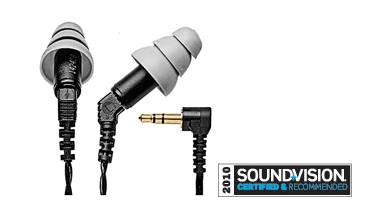In-Ear Headphones Face Off Page 8

Etymotic Research ER-4P Micropro
Key Features |
| $300 Etymotic.com |
| • Accessories: 7 pair ear tips, 1/4-inch adapter, shirt clip, replacement nozzle filters and tool, carry pouch, storage box • Impedance/Sensitivity: 27 ohms/102 dB/mW |
Etymotic Research, another company originally focused on hearing-aid design, more or less created the in-ear category back in 1984. The ER4 was introduced in 1991, making it a genuine archeological relic in this field. The fact that it is still sold today in more or less original form attests to its sound quality.
Etymotic sells two additional versions of the original ER4: the ER-4P (for power) and the ER-4S (for stereo). The ER-4S offers a more accurate frequency- response curve than the 4P. Unfortunately, its high impedance and low efficiency make it a bad match for portables, so the ER-4P was introduced for use with iPods and the like. The ER-4P shares space with the Ultimate Ears TripleFi as the loudest and most efficient earphones I tested.
There's nothing impressive cosmetically about the ER-4P; the earpiece is a plain gray plastic tube with a tip on it. It looks cheap and feels a little cheesy next to the fancy design and construction offered by some of its competitors, notably the Klipsch. But in the end, it's the sound that counts.
PERFORMANCE
The test tones showed solid bass energy from the ER-4P down to about 25 Hz before noticeably rolling off, which put it right up there with the better bangers in our test. On the 20-Hz to 20-kHz sweep, a slight peak was also audible around 5 kHz - something that's clearly marked in response curves found in the company's technical literature. This mild boost was likely evident on the dedicated instrument tracks, where I detected a little extra presence versus my reference 'phones and some of the other top contenders. I found the ER-4P to be a little more etched and perhaps less silky in the midrange than the Sennheiser IE8 or Sleek Audio SA6, for example, though its sound wasn't grating or unnatural. It pushed out the brassiness of horns a little more, for example, and brought vocals a touch more forward. This extra detail and immediacy came at the expense of some smoothness. Pick your poison.
Irrespective of modest differences in the tonal balance, the ER-4P proved its superiority over most of this lot with its openness and dynamics on the demanding music tracks I threw at it. Along with my reference monitors and the UE TripleFi, it really delivered the Stravinsky recording with unstrained clarity and with subtle dynamics intact. Instruments were painted on a broad, airy canvas: Strings sounded beautifully textured, horns were full-bodied, and the triangle displayed big, round notes with sharp, transient strikes. The ER-4P's good bass performance and efficiency allowed it to deliver the timpani finale with finesse and no evidence of breakup. The other, less demanding tracks, such as Amanda Marshall's "The Gypsy" and Michael Ruff's "Wishing Well," came across as very balanced, crisp, and open sounding, with excellent imaging and a lifelike presentation.
BOTTOM LINE
Eighteen years after introducing its ER-4, Etymotic Research still scores with a product that can truly be defined as classic. If you're shopping near the low end of our price range and looking for 'phones that sound incredible on a wide range of music, you won't go wrong with the ER-4P.
























































